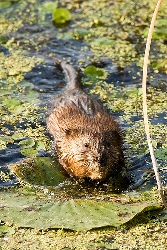
Classification:
A trip down evolutionary lane
The scientific name for the common muskrat, Ondatra zibethicus, comes from Indian and latin roots. The Indian name for the muskrat is Ondatra, and the Latin word zibethicus means musky in odor. A source of the name muskrat is believed to have come from the old English word musquash. This word was taken from the word móskwas, which was used by a group of Native Americans in North America hundreds of years ago.
Below is the classification of the common muskrat, Ondatra zibethicus. Defining characteristics are listed for each of the taxa:
| Domain | Eukarya | cells have a true nucleus and membrane-bound organelles; exhibit mitotic cell division; reproduce sexually; multicellular. |
| Kingdom | Animalia | multicellular; heterotrophic; motile at some stage in life; lack cell walls |
| Phylum | Chordata | bilateral symmetry; highly cephalized; segmented body; triploblastic; coelomate; complete digestice tract; notochord; dorsal tubular nerve chord; pharyngeal pouches; endostyle; post anal tail present during some point of the life cycle |
| Class | Mammalia | body covered with hair; endothermic; glands present (sweat, sebaceous, mammary); extreme parental care; nourish young with milk; internal development of embryo; jaws |
| Order | Rodentia | relatively small body size; continuously growing pair of incisors; primarily herbivorous; rapid rate of reproduction |
| Family | Muridae | pointed snout; whiskers; enhanced sight and smell; elongated body shape; scaly tail; powerful jaws; rapid rate of reproduction |
| Genus | Ondatra | the only organisms that belong to this Genus; semi-aquatic; webbed hind feet; long flattened tail;protruding incisors |
| Species | Ondatra zibethicus | The Common Muskrat, found in parts of Eastern United States and Canada, and also parts of Europe and Asia. See Habitat and Geography for more information |
This tree shows which domain the common muskrat belongs to and its closest living relatives under the taxa Kingdom. This is based on molecular differences that separate the common muskrat from Archaea and Bacteria. As stated above, the common muskrat is a Eukaryotic organisms because it is multicellular, its cells contain nuclei and membrane-bound organelles, and its cells divide via mitosis. Animals are most closely related to Fungi, however there are many differences between the two kingdoms that distinguish the two groups. Some of these differences are methods of reproduction, movement, and nutrient acquisition.
The tree below is based on morphological and evolutionary data as
it progresses from the left to the right. The left side starts with
the Kingdom Animalia and shows some of the muskrat's more common
relatives as you move from one taxa to the next. To keep the tree
from becoming too complex I have left out groups belonging to each
different taxa and only kept the ones that are more closely related
to Ondatra zibethicus. Although I left out many groups, you
can see how the Kingdom transitions to the Phylum and so on. The
traits that distinguish the groups in the Kingdom through the Class
are based on evolutionary similarities and differences such as how
the organisms are supported, and the extent of their digestive,
circulatory, and nervous systems. Muskrats have very complex
digestive, circulatory, and sensory systems which has allowed them
to survive and prosper for so long.
Click on the thumbnail to view another tree!
To learn more about the common muskrat's habitat,
click here.
To go to the home page, click here.
